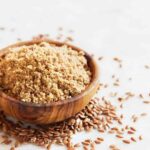Is it a Myth that Wheat (Gluten) is Bad?
What’s the difference between GMO and hybridized grains?
One of the most important ways I educate, in blogging, authoring books, and public speaking, is to point out how billion-dollar industries have falsely educated us, to make a profit. About nutrition, medicine, and health.
If you want the quick abstract of this article, scroll to the bottom! If you want a bit more detail, let’s talk about the gluten-free industry—read on! And whether wheat is actually bad for you. And what to do about it!
In the past, I’ve talked about the billion-dollar fish oil industry, which has done NOTHING to improve cardiovascular health. I’ve talked about the billion-dollar protein industry, which feeds us endocrine disruptors and toxic animal products. I’ve talked about the mega-billion-dollar pharmaceutical industry, whose agenda is to get people to eat chemicals for every health problem, to our toxic detriment, solving no health problems.
The low-fat food cult gave rise to a billion dollars in sales for the processed food industry, who fabricated all kinds of fake foods in the name of us getting skinny and healthy. Currently, the reigning cult, low-carb, has us spending billions in processed food that artificially increases protein and decreases carbohydrates. (Another topic, for another day: carbohydrates aren’t bad!)
We also now have thousands of companies selling us “gluten free” foods. One of my issues with the vast majority of these foods is that, while they’ve eliminated hybridized gluten grains, they are still processed foods with many other negative effects on health.
I’m not going to argue that you should eat gluten as much as you want. The problem isn’t with gluten in its original form. It’s with hybridized grains. A few generations ago, industry began hybridizing our wheat in order to increase protein content and make “better” bread. Many experts are calling what now masquerades as food “FrankenWheat.” Dwarf wheat, the genetic result, bears little resemblance to what your great-grandmother baked in her bread. Your great-grandmother’s wheat had 14 chromosomes. Yours now has 28, causing the body to produce antibodies to fight inflammation, and causing celiac disease and gluten intolerance. New research shows that 55 different conditions, including cancers and irritable bowel, depression, and many auto-immune conditions, can be the result. (You can search in PubMed and read for hours, as I did.)
Long story short, the gluten, or protein, in wheat, is now so altered that it causes all kinds of auto-immune problems in human beings. Many are even being diagnosed with celiac disease, a severe gluten intolerance, where the sufferer is often ill for years before finally being diagnosed and being forced to take up a vigilant nutritional lifestyle, reading labels and eating foods that are manufactured in facilities where there is no gluten.
(There are several other problems with wheat, now. According to Dr. Mark Hyman, M.D., our hybridized wheat, even “whole grain,” not only contains a “super gluten” that causes gut inflammation, it also contains a starch that causes you to gain weight and a chemical drug to make you crave more.)
The gluten-free label is now on a million different products all over North America. Ill-educated Americans often believe that “gluten free” means “good for me.” Nothing could be further from the truth. Gluten-free products are usually full of corn syrup, sugar, chemicals, hydrogenated fats, and not much of nutritional value.
I do think it’s wise to avoid all hybridized wheat products. Even “whole grain” wheat products. And all refined wheat products, especially, which are gluey and slow down digestive function, in addition to spiking blood sugar. Products with white flour include the description “wheat flour” on ingredient labels. “Wheat flour” means white flour–the grain has been stripped of its bran and germ (the fiber and nutrition).
Only “whole wheat flour” means that the bran and germ have not been removed. When even whole wheat is ground very finely, however, for cookies or pastries, for instance, the impact on blood sugar is quicker, with more deleterious effects. Coarse-ground, and even better, soaked/sprouted, grains are much better. When you soak a grain, you neutralize the enzyme inhibitors, making micro-nutrients more bio-available, and the grain easier to digest.
If grains aren’t organic (non-hybridized, pesticide-free), we really shouldn’t eat them at all. I do not feed my family white flour products. I minimize even whole-wheat, using only organic grains. If it is certified organic, it has not been hybridized, nor has it been genetically modified, nor has it been treated with most chemicals.
By the way, people often tell me that wheat is genetically modified, and I have to correct them. Most corn and soy, in the U.S., has been genetically modified. This process involves inserting or deleting genes in gene-splicing technology.
Hybridization, on the other hand, involves crossing different strains, to generate new characteristics. Some breeders even use chemical and x-ray mutagenesis to mutate the wheat. BASF’s Clearfield Wheat, for instance, was created using the toxic industrial chemical, sodium azide. When the seeds and embryos mutate, their offspring continues the mutation.
(Side note: this highlights how as we eat a toxic diet, and mutate our own genetics in deleterious ways, we pass down degenerated DNA to our children! Another reason to eat a very healthy, organic plant-based diet.)
In wheat hybrids, the breeders’ goal is to increase the amount of protein to make bread with more appealing texture. With genetic modification (corn and soy), Monsanto and other companies are looking for more pest resistance and higher yields.
Bizarrely, the wheat industry claims that its product is safe since it isn’t genetically modified. (They’ve tried! If they could gene-splice wheat, they would! And they are working on it.) The wheat industry is under fire as researchers and educators, such as Dr. William Davis, author of Wheat Belly, point out that your consumption of hybridized wheat likely is part of why you have flab on your belly–not to mention many auto-immune conditions. Just because wheat isn’t genetically modified doesn’t mean it’s “good for you.”
Sure, wheat is referred to as the “staff of life” in the Bible. But 2,000 years ago, mankind had not yet started to alter Mother Nature.
Wheat is probably a perfectly legitimate food, if we eat non-hybridized versions. After all, many cultures ate it for 100,000 years! It’s inexpensive to grow and to prepare, and people enjoy it. Spelt and Kamut and Einkorn are ancient grains that have not been hybridized, and becoming newly re-popularized. They are lower in gluten naturally than typical semolina wheat.
I believe that the longer we ignore the risks and indulge in white-flour products, and even in hybridized whole-grain flour products, the more severe our individual gluten sensitivities will become. My own personal response to burgeoning information about wheat, is to choose only organic (non-hybridized AND free of pesticide), and usually sprouted, wheat options. The Good Earth stores, where I live, have sprouted, organic English muffins, breads, and tortillas. Even those, I don’t eat very often—not every day, and sometimes not for weeks at a time.
I believe if we allow our inflammatory conditions to progress, most or all of us will eventually be in the position of having to become a diet vigilante and avoid anything even produced in a facility with a gluten product! So, better to become careful label readers and avoid flour products NOW. That way, if you’re like me, a little piece of bread now and then doesn’t cause a reaction.
I also think that eating 60-80 percent raw plant foods, every day, every meal, as I have been doing for 20 years, is a great preventative for gluten intolerance and the inflammation that comes with eating a diet containing occasional hybridized gluten.
On another note: wheat products also often contain yeast. Modern yeast does not die in the gut. It is bred to be “fast acting” and “quick rising” in this age of impatience, where food has to be prepared quickly or no one will do it! This is not what people did, for thousands of years. In ancient times, people baked bread from natural yeast spores in the air, with slow-growing sourdough starters where the less-virulent yeast died in longer baking periods.
One of the worst diagnoses I know of, is candida albicans yeast overgrowth. It is very difficult to get rid of, and takes a long, sustained effort of starving the body of ALL sugars to be successful, even fruit. It’s a very tough diet to follow.
I have known many people who suffer with chronic low energy, depression, and much suffering before finally being diagnosed with candida. This may be related to diets high in yeast, white flour, and processed sugars, as well as use of antibiotics (which leave the body vulnerable to yeast growth). So, wheat is very problematic for all the reasons we’ve discussed, but eating wheat in combination with yeast is truly begging for health problems.
I’m a big fan of Dr. Jeffrey Smith, a pioneer in the anti-GMO movement. He did a recent study showing that getting people off GMO’s ended gluten sensitivity. This makes no sense, if you believe that gluten sensitivity is the real problem. But what he found was that people were sensitive to genetically modified ingredients, and the processed ingredients, in the packaged foods they ate. It’s something to consider. What if we religiously avoided all corn and soy, all foods not labeled “NON-GMO PROJECT” or “ORGANIC” and ate mostly greens, fruits, vegetables, legumes, non-hybridized whole grains, nuts and seeds?
IN SUMMARY: I agree with the gluten-free proponents, that we must stay away from hybridized grains, even “whole grains” that are hybridized. You know they aren’t hybridized if they are certified organic. White flour products become “glue” in the intestines, and grain products also often contain fast-rising yeast, which leads to yeast imbalance in the body—two additional reasons to avoid most bread products.
Where I wave a white flag, though, is that unless your gut is severely compromised (celiac disease and other very significant gluten intolerance, where staying away from all gluten for a very long time is necessary), the rest of us should still be able to eat limited amounts of organic, ancient wheat and other grains. Sprouted, organic, yeast-free grain products are my favorite. Science has not yet genetically modified wheat. Hybridization involves crossing different breeds to eliminate or promote certain characteristics, and genetic modification involves gene splicing.
Posted in: Whole Food













